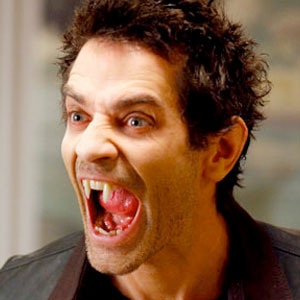 John P. Johnson/HBO
John P. Johnson/HBORegarding True Blood: Why are the vampires' fangs are on their laterals and not their cuspids? I work for a dentist, but we can't figure out why they did this. I always thought vampire fangs were on their cuspids. Hope you can help me because it's driving me crazy.
—Amanda, via the inbox
Indeed, as Sookie might say, that mystery has driven many a folk crazier than a run-over coonhound. In other words, you're not the only fan whipsawed into a state of insanity by True Blood's anatomical whims. Why, for the love of Godric, why? Well, here you go...
First of all, you should know that vampires have a long history of arbitrary fang placement. True. Yes. It goes back at least as far as the 1922 classic Nosferatu, whose main monster looked like a carnivorous mole rat thanks to a pair of fangs where his two front incisors should have been.
Fast forward a few decades, and you have the neo-classic The Lost Boys, in which Kiefer Sutherland and others sported pointy lateral incisors, just like the vamps on True Blood.
And don't forget 30 Days of Night; every single monster tooth was a pointy, deadly little corn nugget. Yes, the classic Christopher Lee Dracula character featured a pair of stabby cuspids—as did Blackula—but as you can see, super-sharp cuspids are far from de rigueur among fashionable creatures of the night.
So why might True Blood show creator Alan Ball have favored lateral incisor enhancement? Well, this is what he told NPR's Dave Davies last year:
"We created fangs that actually lie flat along the roof of the mouth and then click into place when a vampire is in danger or aroused or ready to feed, much like a rattlesnake's fangs click into place. Then we put the fangs not with the four front teeth between them, but with only two because it worked better for the physiology of the rattlesnake, the snake fang working.
"And I like that, because it looks a little different. It doesn't look like the classic thing."
See? Vampire science and all that.
It also helps that the fangs are easier to see. Alexander Skarsgard would have to grimace more widely for the cameras if his fangs protruded from his cuspids.
"Canines have been the vampire creator tooth of choice for centuries," mulls dentist Timothy Chase of SmilesNY, "but I have to say the switch to incisors is pretty cool because you get to see it more."
Plus, in choosing an unexpected place for vampire fangs, Ball's team has created an additional layer of fear and tension.
"The canine is typically a very masculine tooth," dentist Clint Herzog tells me. "By adapting the lateral, which is typically a very feminine tooth, it gives the True Blood vampire a much more aggressive look, fitting for the show's characters."
"It does give a very ominous and dangerous look," echoes fellow dentist Ramin Tabib. "Sort of the contemporary vampire look that dares to be different, which is what the show is all about."
Well, yes, that—and bunches of beautiful supernatural guys running about shirtless.
________
See all the stars show their teeth in our True Blood Season Three Premiere gallery.